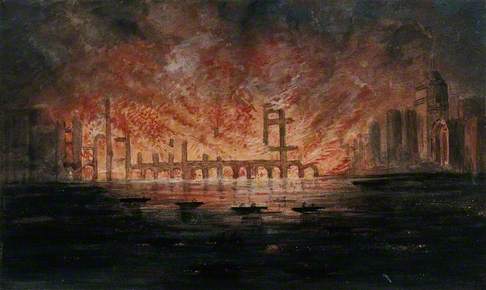British 19th C, except portraits, British 20th C, except portraits, London: Artists and Subjects 14 comments Where is this conflagration, and what is on fire?

Photo credit: Wellcome Collection
From the style of the buildings on the right, this gouache painting looks as though it is of either a very late 19th or early 20th century American incident and waterfront location (and presumably therefore by a US hand). Can anyone suggest where?
14 comments
Could it be the Great Chicago Fire of 1871.?
William Schupbach (Wellcome Collection) has commented, 'The painting is laid down on what looks to me like 19C or early 20C card. There is gum arabic (or similar) on the watercolour/gouache painting. On the verso of the mount, at the bottom, there is a faint inscription in pencil, in two lines, the lower of which appears to say something like Destruction of Westminster [...] and a price, possibly 3/-. Looks as if someone assumed it was the burning of the Houses of Parliament (being a well-known large building on a river that was to a large extent destroyed by fire). Any other ideas will be gratefully received. Images attached.'
Could it possibly be the Tooley Street fire of 1861?
It certainly looks like a waterfront warehouse fire (and not like other images of the 1834 destruction of old Westminster Palace) but the buildings look very 'un-London-like' including in comparison to Scott's image immediately above. I can barely see the backing-sheet inscription on-screen I'm afraid so we may not get further with that here.
Washington Post 22 June 2014 article by Jonathan H Adler refers to many large USA river fires in American cities among them Cleveland, Detroit. Buffalo
and refers to an article by David and Richard Stradling in Environmental history July 2008, which might help in the case of Cleveland
The Rouge River, Detroit seems a possibllity see The Metro Times article by Michael Jackman 'no city has fire flaming up in its history quite like Detroit' 29 October 2014
That in 1915 resulted in the burning of the Belle Isle Bridge
in 1892 there was a large fire in Philadelphia on the Schuylkill River too
On the right edge- the tower building-- looks a bit like the Bank Of China building on the Bund in Shanghai .
https://en.wikipedia.org/wiki/Bank_of_China_Building,_Shanghai
The vessels are in quite similar positions in this work by T. Baynes.
https://victoriancommons.wordpress.com/2012/10/16/parliament-destroyed-by-fire/
Suggest that the artist is intending to convey more than fire - and the Washington Arsenal explosion of 1864 comes to mind. The Arsenal explosion was newsworthy and significant enough to mark, the Arsenal was located on a waterfront with a long range of buildings of varying heights, and did seem to feature a sort of beach area (which may be the dark area on the right hand side.
Apologies if this is a wild goose chase, but it seemed worth pitching in the absence of data, provenance, location information or much else from the collection.
http://www.streetsofwashington.com/2017/08/the-washington-arsenals-explosive.html
Are we not falling into the trap of simply assuming that the painting is of an actual incident at a specific waterfront location?
Nobody has made any suggestions as to who the artist might be. Is there any unusual or idiosyncratic feature of the painting that if enlarged might help identify him, or her, which might help point to what the painting is meant to portray
Having originally asked the question, my view (no more) is that it is too literal in the plain structure of the burning building and quite specific in the design of the city towers (right) to be just an imaginative exercise. The spectacle clearly appealed but take away the fire and the waterfront building shown burning would not be of pictorial interest. Either the towers -which suggest USA - will eventually be identified (though not yet) or we will have to give up.
Without images of the American fires it is hard to make comparisons with ours. The Washington Arsenal was a very different building. This is is clearly riverside warehouses and I have some sympathy with Scott's suggestion that it is supposed to represent the Tooley Street 1861 fire. The buildings are comparable, and the building on the right may be supposed to be St Olave's church. At present this is my favoured recommendation.
If there is any title change, I think it would be safer to call it 'A waterfront warehouse on fire at night', with additional comment that it appears to be late 19th/ early 20th century and that the buildings suggest an American city. I see no resemblance to the Tooley Street area, or St Olave's and fear that would further misdirect.
